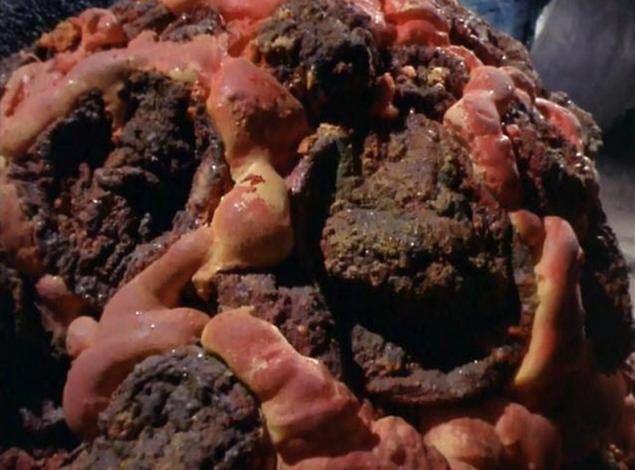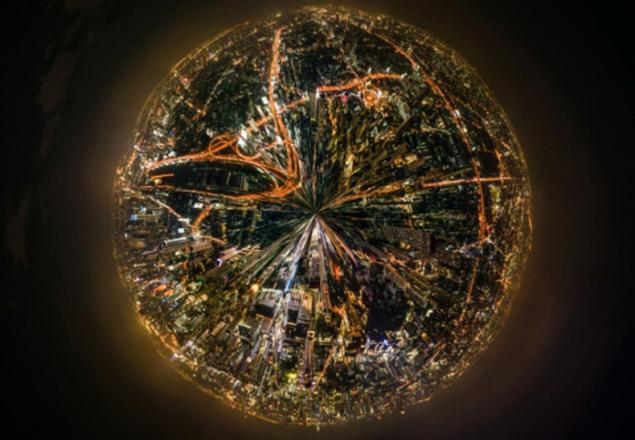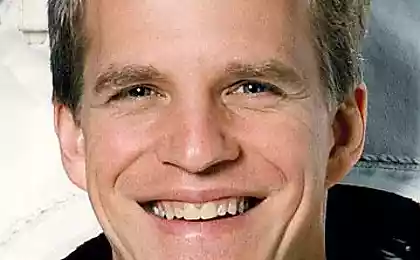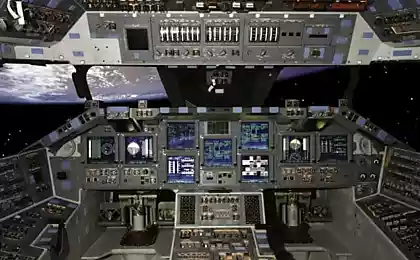736
The solar system is an anomaly in space
Over the past four years, thanks to the space telescope "Kepler", we learned that in our galaxy, so many planets. But the most interesting fact that has produced for us "Kepler" — is that among all those planets are nothing like our Solar system.
This fact is perfectly visible on the example of animating the Planetarium Kepler IV," created by graduate student of the Department of astronomy at the University of Washington Ethan Kruse. It Kruse compares the orbits of hundreds of exoplanets from Kepler's database with our own Solar system, which at the animation shown on the right, and immediately catches the eye. The animation shows the relative size of the Kepler planets (although, of course, not on the scale comparable to their stars), as well as surface temperature.
And yet ...
The animation is very easy to notice how strange is the Solar system compared to other systems. Prior to the mission, "Kepler" in 2009, astronomers expect that the majority of exoplanetary systems will be works like this: a small stone of the planet closer to the center, the huge gas giants in the middle, and icy pieces of rock on the periphery. But it turned out that life is much more bizarre.
"Kepler" has found "hot Jupiters", large gas giants that are nearly touching the star system. As he explains Kruse, "device "Kepler" dictates that it is much better pinpoint of the planet with more compact orbits. In smaller systems, the planets circling in orbits faster, so the telescope much easier to spot".
Of course, the anomaly of the Solar system on the General background can be due to the fact that our knowledge of other systems is still insufficient, or because, as explained above, we notice a smaller system with a fast frequency of movement. However, "Kepler" has found 685 star systems, and none of them not similar to ours.
Let's think, what could be extraterrestrial life?
Given the size of the Universe, there are good reasons to assume the existence of life beyond earth. And some scholars firmly believe that it will be discovered by 2040. But how actually looks (if they really are) intelligent extraterrestrial life forms? For decades science fiction has described to us alien as a short grey humanoids with large heads in General, not much different from the human species. However, there are at least ten good reasons for believing that intelligent extraterrestrial life does not like us.
Planets have different gravity

Gravity is a key factor in the development of all organisms. In addition to the restrictions on the size of land animals, gravity is also the reason why organisms can adapt to different environmental changes. Behind examples far to walk not necessary. All the evidence are in front of us on the Ground. According to the history of evolution, organisms that once I decided to get out of the water onto land had to develop a complex of limb and skeleton, as their body no longer supported by the fluidity of water, which compensated for the effects of gravity. And although there is a range of how strong is gravity in order to maintain the atmosphere of the planet and not to crush on its surface the rest of the range this can vary, and thus may vary the appearance of organisms that have adapted to it (gravity).
Assume that the force of gravity of Earth will be twice the current. This, of course, does not mean that all complex organisms will look as a dwarf cherepahoobraznoy being, however, the probability of upright bipedal humans would be drastically reduced. Even if we can keep the mechanics of our movement, we will become much lower and will have more dense and thick bones of the skeleton, which will allow us to compensate for the increased force of gravity.
If the force of gravity will be twice lower than the current level, likely to have the opposite effect. Terrestrial animals now do not require the availability of powerful muscles and strong bones. In General, all will become taller and larger.
We can endlessly theorize about the General characteristics and effects of high and low gravity, though the finer points of adaptation of the organism to certain conditions we predict are not yet able. However, this adaptation will definitely be visible in extraterrestrial life (of course, if we find it).
Planets have different atmosphere

Similarly to gravity, the atmosphere also plays a key role in the development of life and its characteristics. For example, arthropods that lived during the Carboniferous period of the Paleozoic era (about 300 million years ago) were much larger than modern representatives. And all this thanks to a higher concentration of oxygen in the air, which amounted to 35 per cent, against 21 per cent, which is available now. Some of the species of that time, for example, are meganeura (ancestors of the dragonfly, whose wingspan reaches up to 75 inches, or an extinct species of giant Scorpions, brontoscorpio, the length of which reached 70 centimeters, not to mention arthropleura, a giant relative of modern millipedes, the body length of which reached up to 2.6 meters.
If the 14% difference in the composition of the atmosphere has such a high impact on the amount of arthropods, imagine what unique things can happen if these differences in volume of oxygen will be much greater.
But we haven't even touched on the possibility of existence of life that does not require oxygen. All this gives us the limitless possibilities of assumptions of how this life might look. Interestingly, scientists have discovered on Earth, some species of multicellular organisms that do not require oxygen for existence, so the possibility of the existence of extraterrestrial life on planets with no oxygen doesn't seem so crazy as it seemed before. Life exists on such planets, would definitely be different from us.
The basis of extraterrestrial life may be other chemical elements

All life on Earth has three identical biochemical characteristics: one of its major sources is carbon, it needs water, and it has DNA, which transmits genetic information to future generations. However, it would be misleading to assume that all other possible life in the Universe will follow the same rules. On the contrary, it may exist under completely different principles.
The importance of carbon for all living organisms on Earth can be explained. First, carbon easily forms connections with other atoms, it is relatively stable available in large volumes and can appear complex biological molecules that are required for the development of complex organisms.
However, the most likely alternative to a basic element of life may be silicon. Scientists, including the famous Stephen Hawking and Carl Sagan, at the time, discussed this possibility. Sagan even brought up the term "carbon chauvinism" to describe our preconceptions about what carbon is an integral part of life in every corner of the Universe. If life is based on silicon really exists somewhere, then it will look not like a life on Earth. If only because silicon requires much higher temperatures to achieve the reaction condition.
Extraterrestrial life does not require water

As mentioned above, water is another important requirement for life on Earth. Water is essential because it can exist in the liquid state even at high temperature difference, it is an effective solvent, is used as the transport mechanism and trigger various chemical reactions. But this does not mean that other liquids will not be able to replace it anywhere in the Universe. Most likely substitute water as source of life, can serve as liquid ammonia, since it shares so many qualities.
Another possible alternative to the water can be liquid methane. Several scientific articles written on the basis of information gathered by the spacecraft Cassini space Agency NASA suggest that life based on methane can exist even within our Solar system. Namely, on one of Saturn's moons, Titan. In addition to the fact that ammonia and methane are completely different substances, which nevertheless may be present in the water, scientists have proved that two substances can exist in the liquid state even at lower temperatures than water. Given this, we can assume that life is not water-based will look completely different.
Alternative to DNA

The third key puzzle of life on earth is a way of storing genetic information. For a very long time, scientists believed that only DNA capable of it. However, it turned out that there are alternative ways of storage. Moreover, it is a proven fact. Scientists have recently created an artificial alternative to DNA — XNA (xenodocheia acid). Like DNA, XNA is able to store and transmit genetic information in the process of evolution.
In addition to the presence of an alternative DNA, extraterrestrial life, most likely, can also produce another type of proteins. All life on Earth uses a combination of just 22 amino acids, which produce proteins, but in nature there are also hundreds of other naturally occurring amino acids, in addition to the fact that we can create in laboratories. So extraterrestrial life not only can have their version of DNA, but also other amino acids for the production of other proteins.
Extraterrestrial life has evolved in a different habitat

While the environment on the planet can be permanent and universal, it can also greatly vary depending on the characteristics of the surface of the planet. This, in turn, may cause the formation of completely different habitats possessing specific unique characteristics. These variations can cause different paths of development of life on the planet. On this basis, the Earth can be divided into five major biomes (ecosystems, if you want). It: the tundra (and its variations), steppes (and their variations), the desert (and their variations), water and forest (and their variations). Each of these ecosystems is home to living organisms that had adapted to certain environmental conditions for survival. While these organisms are very different from living organisms in other biomes.
Creating depths of the oceans, for example, have several adaptive features that enable them to survive in cold water, without any light source and thus under the influence of high pressure. These organisms not only not just from man, they are unable to survive in our terrestrial habitats.
For all these reasons, it is logical to assume that extraterrestrial life will not only radically different from the earth in accordance with the General environmental characteristics of the planet, but will vary according to each biome on the planet. Even on Earth, one of the most intelligent living organisms — dolphins and octopuses — not living in the same habitat, and people.
They may be older than us

If you believe the view that intelligent extraterrestrial life forms may be more technologically advanced than the human race, it is safe to assume that there are these intelligent extraterrestrial life forms before us. More likely, this assumption becomes, if you consider that life as such in all the Universe appeared and developed not at the same time. Even the difference in 100,000 years is nothing compared to billions of years.
In other words, all it means is that extraterrestrial civilizations not only had more time for development, but also more time for the controlled evolution of process enabling technology by changing their own bodies depending on the needs, instead of waiting for the natural course of evolution.
For example, such forms of extraterrestrial intelligent life could adapt their bodies for long space travel, by increasing the duration of their lives to the exclusion of other biological constraints and needs, for example, respiration and need for food. This kind of bioengineering could definitely lead to a very peculiar state of the body of the organism and may even have brought extraterrestrial life to replace their natural body parts with artificial.
If you think all this sounds a bit crazy, you know — humanity moves to the same. One striking example of this is the fact that we are on the verge of creating "perfect people". Through bioengineering, we will be able to genetically modify embryos to obtain certain skills and characteristics of the future person, such as intellect and growth.
Life on wandering planets

The sun is a very important factor is the presence of life on Earth. Without it, plants will not have the ability of photosynthesis, which will eventually lead to the complete destruction of the food chain. Most life forms will die within a few weeks. We're talking about one simple fact — without the sun's heat the Earth will be covered with ice.
Fortunately, the Sun soon to leave us is not going to. However, only in one of our milky Way galaxy has about 200 billion of "wandering planets". These planets don't rotate around stars, but only meaningless floating through the darkness of space.
Whether the planets can have life? Scientists theorize that under certain conditions it is possible. The most important issue in this is that these planets will be a source of energy? The most obvious and logical answer to this question may be the heat of his internal "engine" that is the kernel. On Earth, internal heat is responsible for the movement of tectonic plates and volcanic activity. And although this, most likely, will be quite sufficient for the development of complex life forms, you should also consider other factors.
One of the theories was proposed by planetary scientist David Stevenson, according to which the wandering planet with a very dense and thick atmosphere could retain heat that would allow the planet to keep the oceans in a liquid state. On this planet life could develop to quite an advanced level, similar to our ocean life, and maybe even begin the transition from water to land.
Non-biological life forms

Another possibility that should also be taken into account, is that extraterrestrial life may present a non-biological form. It can be as robots, which were designed to replace biological bodies with artificial, and created by artificial means in other species.
Seth Shostak, the head of the program of search for extraterrestrial intelligence (SETI), even believes that such artificial life, more than likely, humanity itself, thanks to the development of robotics, Cybernetics and nanotechnology, sooner or later it will eventually do the same.
Moreover, we are getting close to creating artificial intelligence and advanced robotics. Who can say with certainty that humanity at some point in its history will not be replaced for durable robot bodies? This transition is likely to be very painful. And such well-known figures like Stephen Hawking and Elon Musk, is already aware and believe that ultimately created the AI could just rise up and take our place.
Robots may be just the tip of the iceberg. What if extraterrestrial life exists in the form of energy entities? After all, this assumption also has some soil. Such life forms would not be constrained by any limitations of physical bodies and ultimately, in theory, also be able to come to the aforementioned physical robot shells. Energy entities, of course, no doubt, will not like people, since they will have physical form and, as a consequence, a completely different form of communication.
The random factor

Even after discussing all the possible factors described above, do not exclude chance in evolution. As far as we (humanity) know, there is no reason to assume that all intelligent life must necessarily evolve in the form of humanoid shapes. What would happen if dinosaurs are not extinct? Would develop them in the process of further evolution of humanoid intelligence? What would happen if instead of us the most intelligent life form on Earth evolved would be completely different?
In fairness, it might be worthwhile to restrict the selection of potential candidates for the possibility of development among all animal species to birds and mammals. However, even in this case are a myriad of possible species that could evolve to a level of intelligence comparable to human.
Such representatives of their views, as dolphins and crows are indeed very smart creatures, and if evolution at some point turned his face to them, then it is possible that they were the rulers of the Earth instead of us. The most important aspect is the fact that life can develop in a variety (almost endless) ways, so the chances that other corners of the Universe there is intelligent life very similar to us humans, in astronomical terms is very low. published
P. S. And remember, only by changing their consumption — together we change the world! © Join us at Facebook , Vkontakte, Odnoklassniki
Source: masterok.livejournal.com/2665619.html
This fact is perfectly visible on the example of animating the Planetarium Kepler IV," created by graduate student of the Department of astronomy at the University of Washington Ethan Kruse. It Kruse compares the orbits of hundreds of exoplanets from Kepler's database with our own Solar system, which at the animation shown on the right, and immediately catches the eye. The animation shows the relative size of the Kepler planets (although, of course, not on the scale comparable to their stars), as well as surface temperature.
And yet ...
The animation is very easy to notice how strange is the Solar system compared to other systems. Prior to the mission, "Kepler" in 2009, astronomers expect that the majority of exoplanetary systems will be works like this: a small stone of the planet closer to the center, the huge gas giants in the middle, and icy pieces of rock on the periphery. But it turned out that life is much more bizarre.
"Kepler" has found "hot Jupiters", large gas giants that are nearly touching the star system. As he explains Kruse, "device "Kepler" dictates that it is much better pinpoint of the planet with more compact orbits. In smaller systems, the planets circling in orbits faster, so the telescope much easier to spot".
Of course, the anomaly of the Solar system on the General background can be due to the fact that our knowledge of other systems is still insufficient, or because, as explained above, we notice a smaller system with a fast frequency of movement. However, "Kepler" has found 685 star systems, and none of them not similar to ours.
Let's think, what could be extraterrestrial life?
Given the size of the Universe, there are good reasons to assume the existence of life beyond earth. And some scholars firmly believe that it will be discovered by 2040. But how actually looks (if they really are) intelligent extraterrestrial life forms? For decades science fiction has described to us alien as a short grey humanoids with large heads in General, not much different from the human species. However, there are at least ten good reasons for believing that intelligent extraterrestrial life does not like us.
Planets have different gravity

Gravity is a key factor in the development of all organisms. In addition to the restrictions on the size of land animals, gravity is also the reason why organisms can adapt to different environmental changes. Behind examples far to walk not necessary. All the evidence are in front of us on the Ground. According to the history of evolution, organisms that once I decided to get out of the water onto land had to develop a complex of limb and skeleton, as their body no longer supported by the fluidity of water, which compensated for the effects of gravity. And although there is a range of how strong is gravity in order to maintain the atmosphere of the planet and not to crush on its surface the rest of the range this can vary, and thus may vary the appearance of organisms that have adapted to it (gravity).
Assume that the force of gravity of Earth will be twice the current. This, of course, does not mean that all complex organisms will look as a dwarf cherepahoobraznoy being, however, the probability of upright bipedal humans would be drastically reduced. Even if we can keep the mechanics of our movement, we will become much lower and will have more dense and thick bones of the skeleton, which will allow us to compensate for the increased force of gravity.
If the force of gravity will be twice lower than the current level, likely to have the opposite effect. Terrestrial animals now do not require the availability of powerful muscles and strong bones. In General, all will become taller and larger.
We can endlessly theorize about the General characteristics and effects of high and low gravity, though the finer points of adaptation of the organism to certain conditions we predict are not yet able. However, this adaptation will definitely be visible in extraterrestrial life (of course, if we find it).
Planets have different atmosphere

Similarly to gravity, the atmosphere also plays a key role in the development of life and its characteristics. For example, arthropods that lived during the Carboniferous period of the Paleozoic era (about 300 million years ago) were much larger than modern representatives. And all this thanks to a higher concentration of oxygen in the air, which amounted to 35 per cent, against 21 per cent, which is available now. Some of the species of that time, for example, are meganeura (ancestors of the dragonfly, whose wingspan reaches up to 75 inches, or an extinct species of giant Scorpions, brontoscorpio, the length of which reached 70 centimeters, not to mention arthropleura, a giant relative of modern millipedes, the body length of which reached up to 2.6 meters.
If the 14% difference in the composition of the atmosphere has such a high impact on the amount of arthropods, imagine what unique things can happen if these differences in volume of oxygen will be much greater.
But we haven't even touched on the possibility of existence of life that does not require oxygen. All this gives us the limitless possibilities of assumptions of how this life might look. Interestingly, scientists have discovered on Earth, some species of multicellular organisms that do not require oxygen for existence, so the possibility of the existence of extraterrestrial life on planets with no oxygen doesn't seem so crazy as it seemed before. Life exists on such planets, would definitely be different from us.
The basis of extraterrestrial life may be other chemical elements

All life on Earth has three identical biochemical characteristics: one of its major sources is carbon, it needs water, and it has DNA, which transmits genetic information to future generations. However, it would be misleading to assume that all other possible life in the Universe will follow the same rules. On the contrary, it may exist under completely different principles.
The importance of carbon for all living organisms on Earth can be explained. First, carbon easily forms connections with other atoms, it is relatively stable available in large volumes and can appear complex biological molecules that are required for the development of complex organisms.
However, the most likely alternative to a basic element of life may be silicon. Scientists, including the famous Stephen Hawking and Carl Sagan, at the time, discussed this possibility. Sagan even brought up the term "carbon chauvinism" to describe our preconceptions about what carbon is an integral part of life in every corner of the Universe. If life is based on silicon really exists somewhere, then it will look not like a life on Earth. If only because silicon requires much higher temperatures to achieve the reaction condition.
Extraterrestrial life does not require water

As mentioned above, water is another important requirement for life on Earth. Water is essential because it can exist in the liquid state even at high temperature difference, it is an effective solvent, is used as the transport mechanism and trigger various chemical reactions. But this does not mean that other liquids will not be able to replace it anywhere in the Universe. Most likely substitute water as source of life, can serve as liquid ammonia, since it shares so many qualities.
Another possible alternative to the water can be liquid methane. Several scientific articles written on the basis of information gathered by the spacecraft Cassini space Agency NASA suggest that life based on methane can exist even within our Solar system. Namely, on one of Saturn's moons, Titan. In addition to the fact that ammonia and methane are completely different substances, which nevertheless may be present in the water, scientists have proved that two substances can exist in the liquid state even at lower temperatures than water. Given this, we can assume that life is not water-based will look completely different.
Alternative to DNA

The third key puzzle of life on earth is a way of storing genetic information. For a very long time, scientists believed that only DNA capable of it. However, it turned out that there are alternative ways of storage. Moreover, it is a proven fact. Scientists have recently created an artificial alternative to DNA — XNA (xenodocheia acid). Like DNA, XNA is able to store and transmit genetic information in the process of evolution.
In addition to the presence of an alternative DNA, extraterrestrial life, most likely, can also produce another type of proteins. All life on Earth uses a combination of just 22 amino acids, which produce proteins, but in nature there are also hundreds of other naturally occurring amino acids, in addition to the fact that we can create in laboratories. So extraterrestrial life not only can have their version of DNA, but also other amino acids for the production of other proteins.
Extraterrestrial life has evolved in a different habitat

While the environment on the planet can be permanent and universal, it can also greatly vary depending on the characteristics of the surface of the planet. This, in turn, may cause the formation of completely different habitats possessing specific unique characteristics. These variations can cause different paths of development of life on the planet. On this basis, the Earth can be divided into five major biomes (ecosystems, if you want). It: the tundra (and its variations), steppes (and their variations), the desert (and their variations), water and forest (and their variations). Each of these ecosystems is home to living organisms that had adapted to certain environmental conditions for survival. While these organisms are very different from living organisms in other biomes.
Creating depths of the oceans, for example, have several adaptive features that enable them to survive in cold water, without any light source and thus under the influence of high pressure. These organisms not only not just from man, they are unable to survive in our terrestrial habitats.
For all these reasons, it is logical to assume that extraterrestrial life will not only radically different from the earth in accordance with the General environmental characteristics of the planet, but will vary according to each biome on the planet. Even on Earth, one of the most intelligent living organisms — dolphins and octopuses — not living in the same habitat, and people.
They may be older than us

If you believe the view that intelligent extraterrestrial life forms may be more technologically advanced than the human race, it is safe to assume that there are these intelligent extraterrestrial life forms before us. More likely, this assumption becomes, if you consider that life as such in all the Universe appeared and developed not at the same time. Even the difference in 100,000 years is nothing compared to billions of years.
In other words, all it means is that extraterrestrial civilizations not only had more time for development, but also more time for the controlled evolution of process enabling technology by changing their own bodies depending on the needs, instead of waiting for the natural course of evolution.
For example, such forms of extraterrestrial intelligent life could adapt their bodies for long space travel, by increasing the duration of their lives to the exclusion of other biological constraints and needs, for example, respiration and need for food. This kind of bioengineering could definitely lead to a very peculiar state of the body of the organism and may even have brought extraterrestrial life to replace their natural body parts with artificial.
If you think all this sounds a bit crazy, you know — humanity moves to the same. One striking example of this is the fact that we are on the verge of creating "perfect people". Through bioengineering, we will be able to genetically modify embryos to obtain certain skills and characteristics of the future person, such as intellect and growth.
Life on wandering planets

The sun is a very important factor is the presence of life on Earth. Without it, plants will not have the ability of photosynthesis, which will eventually lead to the complete destruction of the food chain. Most life forms will die within a few weeks. We're talking about one simple fact — without the sun's heat the Earth will be covered with ice.
Fortunately, the Sun soon to leave us is not going to. However, only in one of our milky Way galaxy has about 200 billion of "wandering planets". These planets don't rotate around stars, but only meaningless floating through the darkness of space.
Whether the planets can have life? Scientists theorize that under certain conditions it is possible. The most important issue in this is that these planets will be a source of energy? The most obvious and logical answer to this question may be the heat of his internal "engine" that is the kernel. On Earth, internal heat is responsible for the movement of tectonic plates and volcanic activity. And although this, most likely, will be quite sufficient for the development of complex life forms, you should also consider other factors.
One of the theories was proposed by planetary scientist David Stevenson, according to which the wandering planet with a very dense and thick atmosphere could retain heat that would allow the planet to keep the oceans in a liquid state. On this planet life could develop to quite an advanced level, similar to our ocean life, and maybe even begin the transition from water to land.
Non-biological life forms

Another possibility that should also be taken into account, is that extraterrestrial life may present a non-biological form. It can be as robots, which were designed to replace biological bodies with artificial, and created by artificial means in other species.
Seth Shostak, the head of the program of search for extraterrestrial intelligence (SETI), even believes that such artificial life, more than likely, humanity itself, thanks to the development of robotics, Cybernetics and nanotechnology, sooner or later it will eventually do the same.
Moreover, we are getting close to creating artificial intelligence and advanced robotics. Who can say with certainty that humanity at some point in its history will not be replaced for durable robot bodies? This transition is likely to be very painful. And such well-known figures like Stephen Hawking and Elon Musk, is already aware and believe that ultimately created the AI could just rise up and take our place.
Robots may be just the tip of the iceberg. What if extraterrestrial life exists in the form of energy entities? After all, this assumption also has some soil. Such life forms would not be constrained by any limitations of physical bodies and ultimately, in theory, also be able to come to the aforementioned physical robot shells. Energy entities, of course, no doubt, will not like people, since they will have physical form and, as a consequence, a completely different form of communication.
The random factor

Even after discussing all the possible factors described above, do not exclude chance in evolution. As far as we (humanity) know, there is no reason to assume that all intelligent life must necessarily evolve in the form of humanoid shapes. What would happen if dinosaurs are not extinct? Would develop them in the process of further evolution of humanoid intelligence? What would happen if instead of us the most intelligent life form on Earth evolved would be completely different?
In fairness, it might be worthwhile to restrict the selection of potential candidates for the possibility of development among all animal species to birds and mammals. However, even in this case are a myriad of possible species that could evolve to a level of intelligence comparable to human.
Such representatives of their views, as dolphins and crows are indeed very smart creatures, and if evolution at some point turned his face to them, then it is possible that they were the rulers of the Earth instead of us. The most important aspect is the fact that life can develop in a variety (almost endless) ways, so the chances that other corners of the Universe there is intelligent life very similar to us humans, in astronomical terms is very low. published
P. S. And remember, only by changing their consumption — together we change the world! © Join us at Facebook , Vkontakte, Odnoklassniki
Source: masterok.livejournal.com/2665619.html
Joint pain: 5 natural anti-inflammatory drugs
Ruby red smoothie beets and Chile: doping, not against the rules!
























